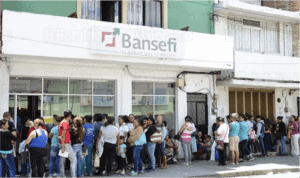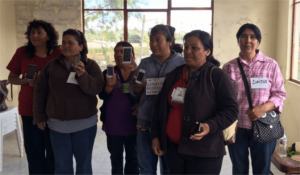More than 170 million low-income individuals globally receive a payment from the government on a regular basis—and the majority of these government-to-person (G2P) payment recipients are women[1].
Digitization of these payments makes sense for governments: reduced distribution costs, fewer leakages, and more transparency. Shifting to digital payments instead of cash, for example, saves the Mexican government an estimated $1.3 billion annually.
The process to digitize is no small feat—governments around the world are overcoming many hurdles to bring millions of G2P recipients into the formal financial system.
However, digitization of these payments is not a seamless onramp to financial inclusion for its millions of recipients, as some industry watchers may claim. Instead, it is just the first step on the bumpy path to financial inclusion. Women’s World Banking is working with one of the world’s most successful digital G2P programs to ease this journey for its millions of recipients, a majority of whom are women.
What is Prospera Digital?
Women’s World Banking began working on the Prospera Digital project in 2016, as part of a consortium of partners led by the Coordinación de Estrategia Digital Nacional (CEDN) of the Mexican government. The objective? To promote financial inclusion of more than 7 million Prospera beneficiaries, 98 percent of whom are women. Other partners include the Behavioural Insights Team, DIRSI, CIDE, and Qué Funciona para el desarrollo.
 Prospera (formerly, Oportunidades) is a conditional cash transfer program founded in 2002 based on a previous program called Progresa, created in 1997. It aims to reduce intergenerational poverty by giving cash to each household to spend on education, health, and nutrition. Bimonthly payments are provided to participating families who meet conditions (corresponsabilidades) around health and education. It has been so successful in driving outcomes for low-income Mexicans that it has been replicated in over 50 countries.
Prospera (formerly, Oportunidades) is a conditional cash transfer program founded in 2002 based on a previous program called Progresa, created in 1997. It aims to reduce intergenerational poverty by giving cash to each household to spend on education, health, and nutrition. Bimonthly payments are provided to participating families who meet conditions (corresponsabilidades) around health and education. It has been so successful in driving outcomes for low-income Mexicans that it has been replicated in over 50 countries.
All Prospera beneficiaries have an account at Bansefi (the government development bank, the only bank that can legally provide the accounts and payments) and an associated debit or chip card, with which they access their G2P payment.
Does digitization close the gender gap in financial inclusion?
According to the 2014 Global Findex, 44 percent of Mexicans have access to an account at a financial institution, with only a 4 percent difference between men and women. This small gender gap is impressive when compared to the overall gender gap in developing countries, which has remained steady at 9 percent.
The small gender gap in Mexico can largely be attributed to the digitization of G2P, given the majority of beneficiaries are women. Mexico has the second largest digitized G2P program in the world where beneficiaries receive payments through an electronic bank account with associated debit or chip cards.
By digitizing G2P payments, the Mexican government has put a bank account in the hands of millions of recipients. This automatic enrollment is a behavioral nudge in the right direction—along the lines of what earned Richard Thaler his recent Nobel prize (congrats!)—as it removes the barriers for low-income populations, especially women, of opening an account.
Because these women have accounts, they are considered “banked.” However, given existing barriers of mistrust or misperceptions around formal financial services, limited financial and digital literacy, and time constraints…can we consider them fully financially included?
Digital G2P payments ≠ financial inclusion
Emerging research shows that when the “state made me save”, dormancy on accounts is reduced. The Global Findex shows that adults who receive a government transfer are more likely to save and borrow formally than all adults. A 2016 study of more than 300,000 bank accounts of G2P recipients in Mexico found that recipients of G2P begin saving after the first six months of receiving their debit card.

Approximately 80 percent of Prospera beneficiaries are in the “closed loop” (canal cerrado): given the lack of banking infrastructure in the rural localities where most beneficiaries live, they must cash out their funds in full at designated bimonthly payment points. The card cannot be used outside of these payment events.
Instead of having an operable bank account, “this restriction effectively renders rural recipients’ accounts into bimonthly, temporary repositories of G2P funds, and nothing more…[cutting] the reach of the digital trail short”, says independent financial inclusion consultant Gabriela Zapata.
The remaining 20 percent in “open loop” (canal abierto) can access their bimonthly payment at any time through Bansefi branches, ATMs, agents, or through cash-back. They can also use the debit card for purchases. Open loop beneficiaries thus have an operable bank account.
She has an account—now what?
However, even among beneficiaries in the open loop, approximately 85 percent withdraw all of their G2P payment at once! If these beneficiaries are living in a community with accessible access points, why were they not using their cards beyond withdrawals?
Women’s World Banking understands from our research in Mexico and in other markets that women have distinct preferences for digital financial services: convenience, reliability, security, and confidentiality. Prospera beneficiaries did not perceive or understand the card or account as meeting these preferences.
We conducted research (in Sept 2016 and Dec 2017) to uncover the behavioral barriers that kept “open loop” beneficiaries from fully utilizing their cards, and in turn, accounts.
“I didn’t know I had a bank account.”

They had limited awareness, trust and confidence on what and how to use the card in other ways beyond withdrawals. Beneficiaries overwhelmingly did not know they even had a bank account linked to the card nor of the card’s benefits.
They were also uncertain whether the funds would still be available if not withdrawn and they feared of pressing the wrong button on an ATM or POS. Many cited being sensitive to any bank fees.
This lack of awareness extended to a program intended to promote financial inclusion of beneficiaries. Programa Integral de Inclusión Financiera (PROIIF) is a bundle of commitment savings, credit, and insurance products, together with financial education, offered by Bansefi. Savings contributions and loan payments are deducted from beneficiaries’ bimonthly payments. Beneficiaries are enrolled in special enrollment sessions and currently over 1.5 million Prospera beneficiaries are participating.
However, we found in our customer research that while PROIIF beneficiaries were more aware of having bank accounts than non-PROIIF beneficiaries, the process for opening and accessing these benefits were unclear. They often did not know if the accounts had been opened, how much they were saving or had saved, how much they owed, or how to access the insurance benefits.
Solutions to reach the “low-hanging fruit” in the open loop
Digitization of G2P payments can be an effective gateway to financial inclusion, but only if beneficiaries have access to a proper ecosystem—ATMs, banking agents, points of sale (POS), and branches.
Convenience also matters a lot: we learned from the Financial Diaries project in Mexico that respondents made over 85 percent of their purchases and financial transactions within a 30-minute walking distance from home. Without conveniently located access points (and reasons to use them), “closed loop” beneficiaries cannot yet fully realize the benefits of digital financial services.
Thus, we focused on solutions for beneficiaries in the “open loop” and beneficiaries migrating from “closed” to “open” loop. They have greater banking infrastructure available and opportunities to digitally use their payments and save in their accounts.
Our understanding of the beneficiaries’ behavioral barriers beneficiaries face combined with a behavioral map of the how they spend and use their money in their communities pointed to two important approaches for the interventions we ultimately designed:
• Highlight relevant use cases of the card and account, beyond withdrawals (purchases, balance inquiry, keeping money); where to use the card and how much it costs; and how to conduct transactions
• Promote specific actions that can drive usage such as leaving some money on the card at the time of withdrawal, and carrying the card (instead of leaving at home) to be able to transact when out and about
The resulting beneficiary and staff-facing interventions we designed together with the consortium of partners include:
• optimized content and design of a notification letter provided to beneficiaries migrating from closed to open loop;
• an SMS series to reinforce information and provide tips;
• updated training content for sessions delivered to beneficiaries on a bimonthly basis; and
• scripts and marketing collateral for Yastás stores, which are Bansefi banking agents.
We are working closely with the consortium partners to rigorously test and measure the effects of these interventions on account usage and will share results once available.
With this approach, we look forward to harnessing the important step of digitizing G2P payments as a true onramp toward increased account usage and ultimately greater financial inclusion of Prospera’s millions of women beneficiaries.
Have you had experience with increasing usage of G2P payments? Comment below or tweet at us (@womensworldbnkg and @RyanNewton_) and tell us what were the key factors for success or what challenges you have faced.
[1] https://www.cgap.org/sites/default/files/CGAP-Focus-Note-Banking-the-Poor-via-G2P-Payments-Dec-2009.pdf



